Every day is washing day at Royal Adelaide Hospital
1857 Laundry
The first laundry on the North Terrace site was co-located with the boiler house and kitchen (west of the old Casualty Building [Terrace Ward] and north of the main Hospital buildings). While the boiler house was fully functioning when the hospital opened in 1856, tenders for the laundry and washhouse were not applied for until January 1857. TW Perryman was the successful builder, with the laundry completed towards the end of 1857, at a cost of two thousand pounds.
At this stage the hospital laundry was entirely staffed by female workers, who lived off-site. As the hospital was opened twenty-four hours a day, seven days a week, so too was the laundry. The amount of work that passed through the laundry was variable; dependent on epidemics, accidents and bed numbers. The types of articles washed were often covered in bodily waste and blood, which also brought a high risk of infection.
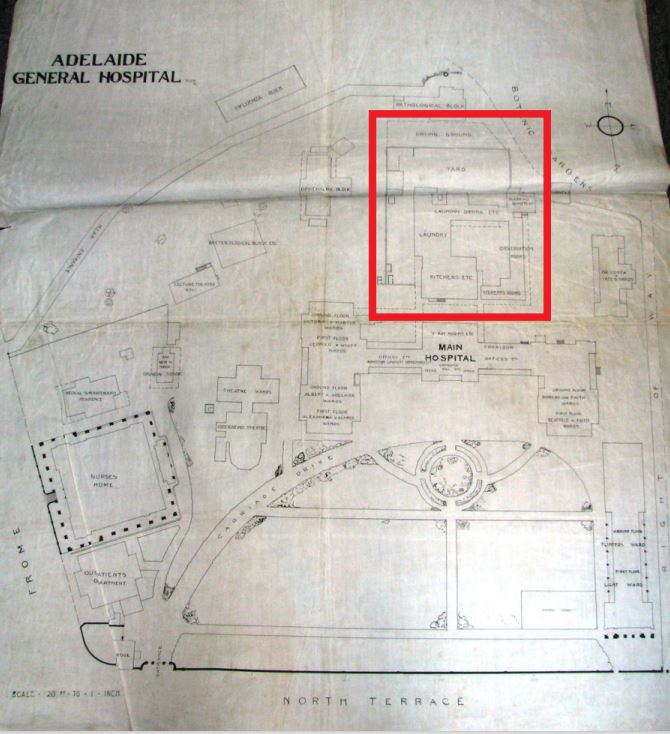
To process the large amounts of soiled hospital washing, the laundry was separated into different areas and rooms: the washhouse, drying room, mangling/ ironing rooms and linen storage rooms.
Washhouse
The first stop for dirty linen was the washhouse. Here the dirty washing was sorted into piles such as heavy or delicates. The smell from the dirty laundry must have been horrible.
Once sorted, the laundry was washed in large tubs piped with hot water from the boiler house next door. In 1868, it was reported in the South Australian Register that the washhouse was:
furnished with one of Bradford & Co’s patent washers; but the laundrywomen prefer following the old-fashioned practice … the drainage is all accomplished by means of pipes, which empty the refuse into tanks, where it passes through a cleansing and deodorizing process. The water, almost in a state or purity, escapes and is conducted by pipes direct towards the Torren River.
28 May 1868
The Bradford patent washer was a simple device consisting of drum and a handle that rotated the drum. Its purpose was to shake the dirt off fabric items.
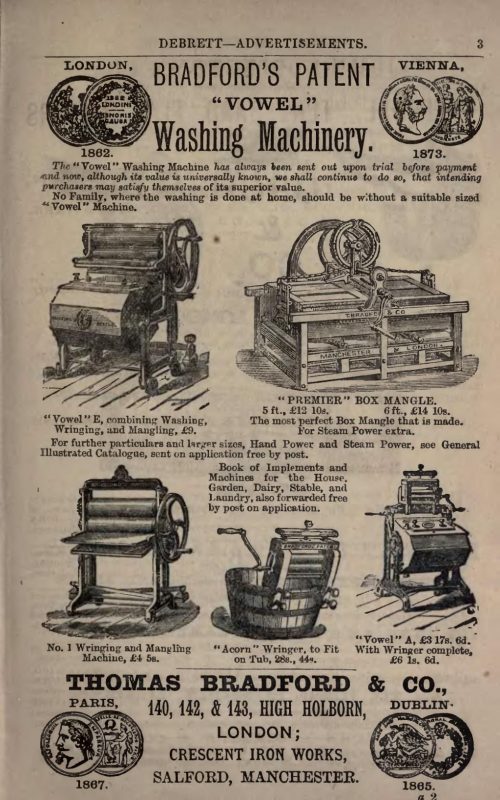
Drying Room
Once the item was washed it was transferred to the drying room. The laundresses needed to be strong enough to lift heavy wet items, not just clothing but bed sheets and towels.
The drying room was heated by means of a furnace, making the room incredibly hot and steamy, particularly in summer months. Before being hung up to dry, the washing required untwisting and shaking out.

Mangle Room
After the drying room, the articles went into the mangle room containing mangles and wringers. These were hand-operated machines consisting of rollers to manually squeeze out all of the water and ‘iron’ the fabric smooth. Again, the laundresses needed to be strong to hand-turn the mangles and have skill to feed the articles between the roller without crushing fingers or arms.
Ironing Room
After all the water had been extracted, those article that required it were starched. This was done in the ironing room, where the item was dipped into a thick starch solution. The now dry washing was ready for ironing. The irons were fire-heated and very heavy. Burns were a common occurrence.
Linen Storage
The last step in the washing process was the checking, repairing and folding of the laundry. This occurred in the linen storage room. Once stored, the clean laundry was placed in wicker baskets, ready to be returned to the wards.
At this time there were four full-time laundresses employed at the hospital.
Washing for Nurses
In the late 1880’s, conditions for nurses came under public scrutiny, with an investigation by a Joint Committee. One of the outcomes was that nurses were no longer required to do their own washing, particularly uniforms. It was agreed that it should be done for them by the hospital laundresses, with an increase in laundry staff. To accommodate the extra staff, alterations on the laundry were completed in 1895 at the cost of 86 pounds.

With the introduction of improved laundry technology and machinery, production and efficiency improved. However, this did not improve the hospital laundresses working conditions. By the end of the century, Adelaide hospital expansion significantly increased the laundry workload and put pressure on its machines. There were now ten laundresses. The laundry was again overcrowded and required rebuilding and refitting with modern appliances.
Laundry Upgrade
In 1907, the Adelaide Hospitals boilers were upgraded which greatly increased steam output. At the beginning of the twentieth century, the original boilers were removed and replaced with two small Cornish boilers with horizontal Worthington steam pumps. These pumps greatly increased steam output: “formerly twelve washerwomen were required to do the hospital work, but since the introduction of the new steam boilers the same duties are performed by four girls.” The Advertiser, 7 August 1907.
At the same time the Superintendent of Public Buildings (Mr CE Owen Smyth) purchased new steam washing machines and mangles for the laundry.
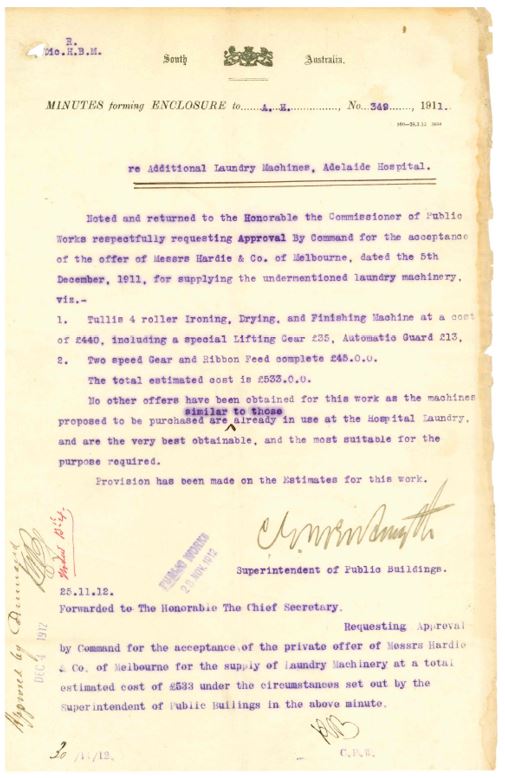
An additional building was erected next the existing laundry to accommodate the new machinery. It had cement floors with special drainage and pipes. This consisted of a Cochran boiler, two Tullis steam washers, a hydro-extractor and a De Coudon ironer and mangler.
The hydro-extractor, a new addition to the hospital, was powered by electricity. After the hospital items were washed in the washing machines, they were transferred to the hydro-extractor. The water was extracted from the fabric by “intense velocity of revolutions of the steel basket, which is turned on a spindle at the rate of 2.000 revolutions to the minute” The Register, 1 June 1907
The De Coudon steam ironer was a flat bed placed over a steam chamber, in which steam was forced with a pressure of 75lb to the square inch. Other additions were extra tanks and other appliances for softening the pipe water and soap mixers.
Questions in Parliament
After the new laundry was established, the Adelaide Hospital Board dismissed four adult laundresses, who were paid 1 pound per week. Not long after they readvertised for four girls under the age of 18, to be paid at 10 shillings a week.

In its collection, the Health Museum holds the 1912 fortnightly reports to the Adelaide Hospital Board from the Laundry Forewomen. These give an insight to the trials and tribulations the laundresses faced:
“The wet and windy weather during the first week and during the beginning of last week made it very difficult to dry the linen” 16/12/1912.
“I have to report that the work in the laundry is steadily increasing. I have taken an average of the number of articles issued from the laundry each day, and find that it amounts to one thousand eight hundred and forty seven machine washed articles. Besides this there is all the nurses’ linen which is mostly washed by hand” 02/12/1912.
“I would respectfully recommend that hot water pipes should be laid on in the laundry to be used when linen is being washed by hand. This is most necessary as so much depends on the early and effectual rinsing of all washed linen. Bad rinsing is generally the principal cause of yellow and grayish coloured linen. It is therefore a grave mistake to plunge the linen wring from the soapsuds of the tub, or copper, into cold water. By this method, the soapy water and suds may be driven out after much agitation in plenty of pure water, but the soap in the tissues is hardened, and in the long run gives a bad colour to the linen, besides causing many troubles in the ironing room such as streaks and black spots. At present all the hot water is being carried in buckets from the kitchen. I would also ask that the hot water pipes were taken through to the soiled linen tank – and to the bath which has been renovated for the use of the laundresses in the room behind the drying room” 26/08/1912.
“The gas irons are in need of repair. The gas escapes up through the handles and often burns the rubber tubing. I would also recommend that two more irons be provided so that the laundresses cannot excuse themselves for bad and slow work on account of cool and insufficient irons.” 01/04/1912.
“Alice Irvine, one of the laundresses scalded her foot while at work a fortnight ago. The foot had been scalded once before on the same place – and, perhaps because of that, it is now healing very slowly, so she has not been at work since the accident” 19/02/1912.
“The heat in the laundry has been intense, and has tired the endurance of the laundresses very much” 05/02/1912.
“The new room with pigeon holes and tables for sorting the nurses’ personal linen, has been finished and it is now in use and is found to be of great help” 15/01/1912.
The Hospital response to the retrenchment, was that the introduction of the new machines, younger girls were more than capable of doing the work. However, “the work was not a great deal less than before; in fact, it was just as heavy as before. On Monday these women had the whole of the washing of Saturday and Sunday to do; it had to be put into the copper and then into the new machinery, where the clothes had to be packed. After the moisture was extracted the clothes had to be dragged out and put through the mangle. It was very heavy work and not suitable for young girls . the women went to work at 7 in the morning and worked often to 6 o’clock in the evening” The Hon Mr Blundell, The Advertiser, 8 August 1907
The Premier, The Honorable Thomas Price, referred the matter back to the hospital, as the management of the hospital was entirely in the hands of the board, although the Government had “no sympathy with the decision”.
Married Laundresses
After World War I and into the second half of the 1920’s, Australia went through what was known as ‘The Great Depression” [1929-1939]. Unemployment in Australia reached 32% and it also drastically changed economic policy and thinking in Australia.
Public opinion at the time thought that working women contributed to the high unemployment levels; that women stopped men from getting jobs. Women with working husbands were targeted.
Board minutes of the Adelaide Hospital, show that there was an inquiry into the married women employed in the laundry whose husbands were earning:
“The Acting Secretary submitted a statement showing the husbands’ earnings of three laundresses. The Forewoman of the Laundry was interviewed and questioned … It was resolved that the services Mrs Manuel and Mrs Hogg be dispensed with”. 15 Jan 1926.
On 30 Jan 1926, two further laundresses, Mrs Johnson and Mrs Perkins were also called before the Board to give particulars of their financial circumstances.
At this time, the hospital began employing men in the laundry as Laundry Assistants, although the bulk of the laundry work was still done by women.
Laundry No 2
Extensive improvements and additions were made to the Adelaide Hospital, including a new steam laundry.
First built was the new Boiler House, followed by the kitchen and laundry. Again these facilities were all co-located close to the boiler house to enable easy access for steam and hot water.
The new laundry opened August 1925 at a cost 20,000 pounds. The old kitchen and laundry block was demolished to make way for the new kitchen and stores block.

The layout of the new building was similar to the old laundry. The furthest room (at the back of the building) was for washing badly soiled linen. It was separately treated and washed by laundry staff that worked shorter hours than the rest of the workers. This was heavy, smelly and difficult work.
The main part of the laundry had a row of washing machines lined up on the left wall. This is where the majority of the linen was washed, rinsed and starched. This was automatically done, taking approximately one hours for the process.
The washing was then lifted out and put in trolleys or trucks and wheeled over to the five ‘hydros’ (water extractors) lined up on the right of the room. These machines dried the laundry ready for ironing. At the end of the building was an electric heavy-duty blanket washer.
Another room held the steam press drying room, where clothes-horse type arrangements held sheets and/or delicates drying in hot air. These could be dried artificially in half an hour.
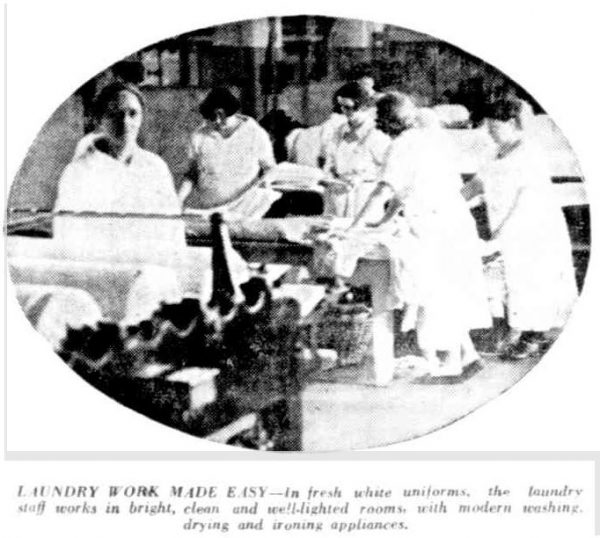
Another section held wringers and ironing machines for smaller starched items like nurses’ caps, collars and aprons. For heavier pieces like quilts there was a steam-heated machine that ironed with eight rollers. Laundresses also used electric irons by hand, pressing collars and doctors coats.
Another room was for checking and packing. A check was kept on the wearing qualities of all hospital linen.

The Medical Superintendent reported regarding an accident which happened to Mrs Woolard, the Forewoman of the Laundry, whose right hand caught in the electric calendar machine. Although Mrs Woolard is still receiving conservative treatment, it is probably that she will lose the top joints of the first and second fingers. The Medical Superintendent inspected the machine and found that the safety device was in good working order.
Royal Adelaide Hospital Board Minutes, 29 October 1941

Adelaide Hospital Domestic Strike
With the outbreak of the Second World War in 1939, life changed for a large percentage of women. As men rushed to enlist, women were expected to reenter the workforce and those working in wartime industries received considerably more pay than those in regular employment, such as laundry work.
By the beginning of 1944, four years into the war, the Royal Adelaide Hospital had great difficulty attracting and then keeping domestic staff. Absenteeism was rife and dissatisfaction high regarding their working conditions. A large portion of the domestics at the hospital were members of the Australia Government Workers Association and in the following months, members of the Royal Adelaide Hospital section of the Association ramped up their meetings regarding their demands for improved working conditions. With no satisfactorily changes implemented by the hospital board and government, 120 domestic staff including the laundry staff, went on strike.
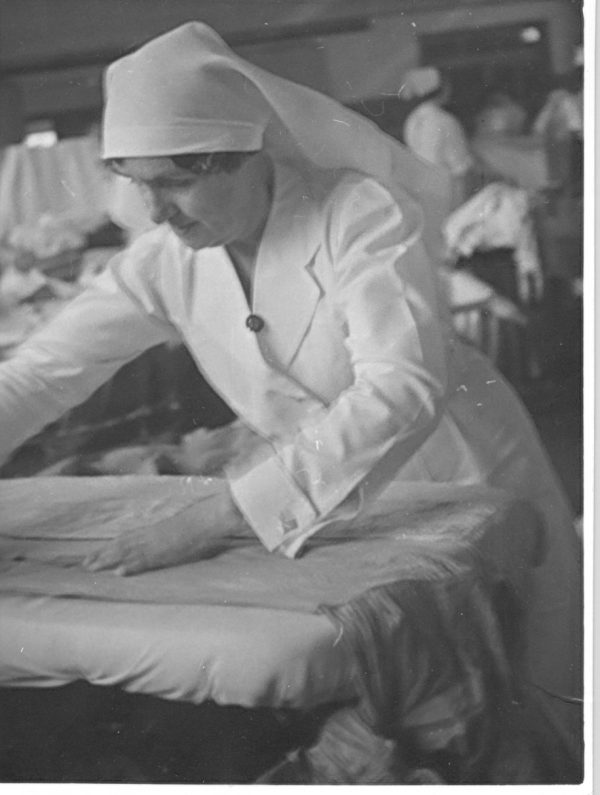
The strike had a profound effect on the hospital; the lack of linen was a major problem. To help alleviate the issue, theatre nurses, probationer nurses, along with members of the office staff were rostered to work in the laundry. Normally there were 25 women working in the laundry, however, it required 40 nurses over the course of the day. The laundry presses were usually operated by four laundresses, but 6 to 8 nurses were required as they were unfamiliar with the work.
The 18 house surgeons at the hospital also gave their services voluntarily, and worked in the wards and laundries, where they operated the washing machines. They helped with the laundry, ironing and sorting out linen. A number of medical students also gave voluntary service, often going straight from the laundry to their lectures.
The Advertiser, 9 August 1944
The strike went on for 10 days before the 120 domestics returned to work. The terms of the settlement included an increase in wages and changes in the way sick leave and overtime were calcuated.
Departmental Laundry Manager
In 1954, the Government began exploring the suitability of a central automatic laundry for all public hospitals and government institutions in South Australia. Similar to the Central Laundry for Melbourne Hospitals and it was also becoming regular practice overseas for a central organisation to cater for all linen services. . This was in response to the opening of The Queen Elizabeth Hospital (TQEH). The hospital’s laundry was being done by the Northfield Wards of Royal Adelaide Hospital and there were no plans to build a laundry on the TQEH site.
As a first step in centralizing hospital laundries, the government created a new position ‘Departmental Laundry Manager’ responsible for hospital laundries around the state. This position was based at Royal Adelaide Hospital.
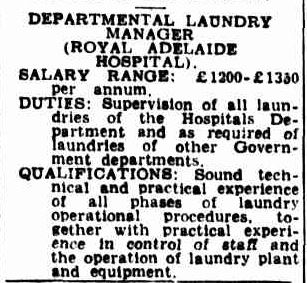
The successful applicant was Mr CS “Tim” Spencer. Tim grew up in Port Lincoln and during WWII joined the Navy, where he spent 9 years.. After leaving the Navy, he completed a course in engineering in laundry steam equipment in Sydney. After three years in Tasmanian he joined the Royal Adelaide Hospital.
The Lay Superintendent reported that the Departmental Laundry Manager was due to take up duty on 22 December and that he would be stationed at the hospital in the same manner as was the Catering Supervisor. He attached a list of the proposed duties and responsibilities of the Laundry Manger, as far as Royal Adelaide Hospital was concerned. Noted and list of duties and responsibilities approved.
Royal Adelaide Hospital Board Minutes, 19 December 1955
Prior to the Departmental Laundry Manager, the Royal Adelaide Hospital laundry workers reported to the Laundry Forewoman, who in turn reported to the Housekeeper. Now the Laundry Forewoman reported directly to Mr Spencer.
Mr Spencer was very active in updating and improving the laundry at Royal Adelaide Hospital. Improvements and alterations made in the first year included (Hospital Board Minutes):
- Replacement of 10 laundry trucks/trolleys (plus an additional 12) with a different design as the current trucks are too small and tip over easily. 23/01/1956
- Purchased an additional 8 laundry ironer feed trolleys – to use with the feeding system he proposed to introduced. This increased the number of sheets put through the ironer by 200% per hour. 06/02/1956
- Ensured regular maintenance and repairs of washing machines and laundry equipment 27/02/1956
- Hospital issued dressing gowns for patients to be washed in the laundry rather than forwarded to dry cleaning as had been the practice. This saved the hospital significant money. 13/03/1956
- Laundry modification and new machinery ie twin roll ironer. 23/04/1956
From 1961, correspondence between Mr Spencer and the hospital board began to decreased; the closer the opening of the Dudley Park facility, the less activity between the Board and Spencer.
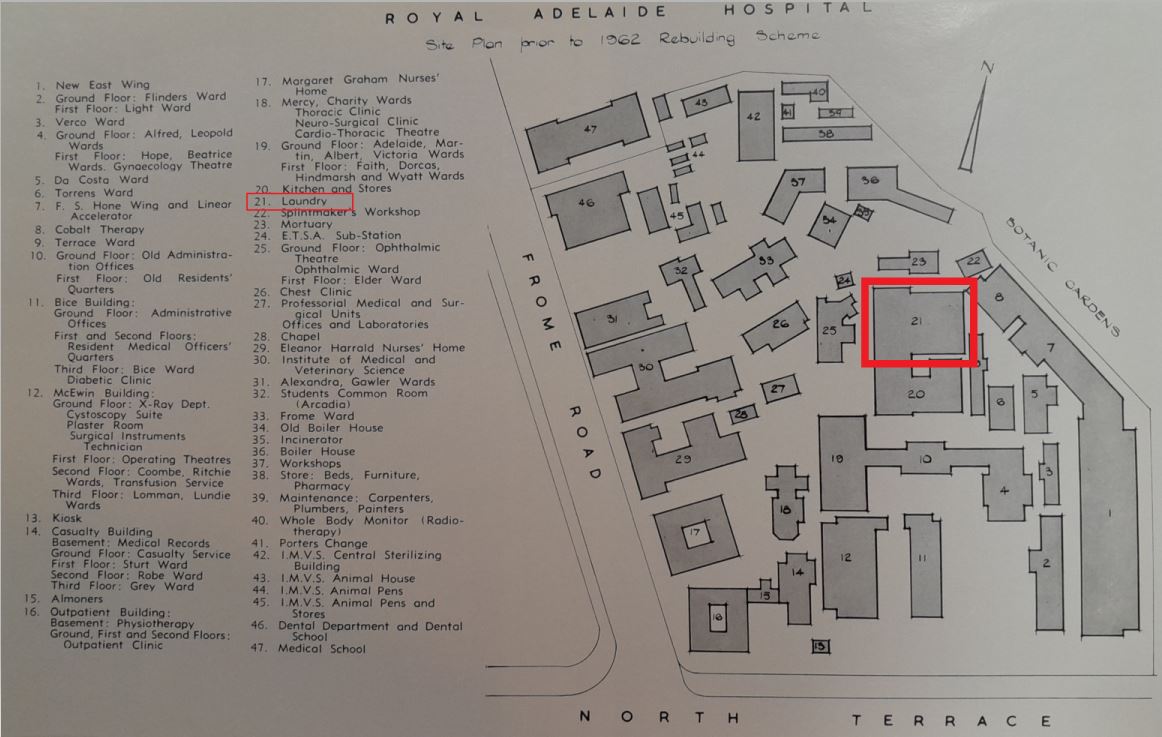
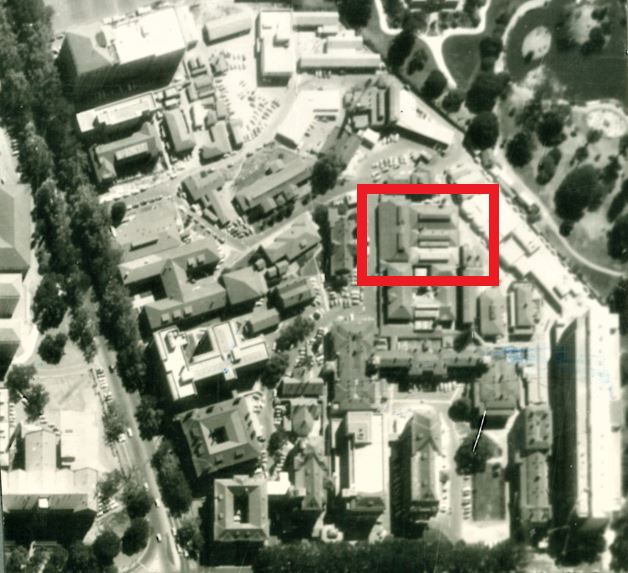
Centralizing Laundry Services
Increasingly, the larger metropolitan public hospitals were providing a group laundry service for neighbouring smaller hospitals, with each hospital maintaining its own stock of linen. The government of the time, felt that this was an inadequate and inefficient system and decided in October 1963 to establish a Group Laundry and Central Linen Service. This services was for all government hospitals and institutions within the metropolitan area.
The Group Laundry was to be operated by the State Government and not a private enterprise as it was felt that the former would be cheaper. A 9 acre site at Dudley Park was chosen because of:
- the availability of suitable water supply;
- availability of main sewerage; and the
- central location relative to the major institution to be serviced.
A Management Committee for four members from the Hospitals Department and Administrators from the larger hospitals, were appointed. No outside consultants were engaged in planning. Mr Spencer, the Departmental Laundry Manger, was appointed as Manager early in the planning phase.
Two years after the decision to establish a centralised system, Dudley Park received its first wash in December 1965. There was no gradual transition to the new system, primarily due to confusion that would occur if two different systems were operating at the same time.
The Administrator reported that the Royal Adelaide Hospital laundry has ceased to operate and that from today the Linen Service will be provided by the Group Laundry and Central Linen Service. Noted.
The Royal Adelaide Hospital Board Minutes, 14 February 1966
Demolition
During the 1960s, the Royal Adelaide Hospital undertook a large redevelopment of the whole site, with the majority of the old buildings being demolished. Included in this was the old kitchen and laundry complex. This space was taken up by the new North Wing.

Written by Margot Way, CALHN Health Museum
(Information sourced from Trove, History Trust, Ancestry, State Library of South Australia and SA Health Museum collection. Copies of all newspaper articles and other relevant documents are available on request).
